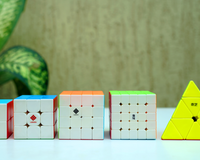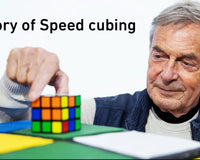Introduction
The original Rubik's Cube was first launched in 1980 and has resulted in creating hobbies and interests in puzzle designing. Rubik's cube has not only been a challenge for most, but it is also a very intricately designed puzzle.
Many individuals and companies have created incredible and harder alternatives to the original Rubik's cubes by modding the pieces. In this article, we cover some of the well-known types of Rubik's Cubes that you should know.
1. 2x2

The 2x2 Rubik's Cube or the Pocket Cube is a version of the Rubik's cube with just two layers. It is also called the Mini Cube. This Pocket Cube might seem very simple to solve at first glance, but it has more than 3.6 million possible permutations! Mind-boggling, isn't it? There are only four stickers on each face of this cube as compared to the colour patterns of the Rubik's Cube. Therefore, the solution is to twist the cube around and pave your own path.
2. 4x4

The 4x4 Rubik's Cube is also called Rubik's Revenge. It was originally created by a Hungarian designer Sebestény Péter. This puzzle has 24 edges, 24 centres and eight corners. It's a mechanism, algorithms and notations are quite similar to the Rubik's Cube. However, the four centrepieces are held together by a hidden centre. There are many more modifications and variants of the Rubik's Revenge that are built on the same mechanism and concept.
3. 5x5

The 5x5 Rubik's Cube is also known as the Professor's Cube. It was invented by Udo Krell. This type of Rubik's Cube has around 2.82 x 1074 possible combinations. This is approximate to the number of atoms in the universe. The method of solving the 5x5 cube is similar to that of the classic puzzle and involves solving the centres, pairing the pieces to create the edges and finally solving it like a 3x3 cube.
4. 6x6

The 6x6 version of the Rubik's Cube was invented by Panagiotis Verdes. However, unlike the other cubes, the 6x6 variant has no fixed blocks. The centrepieces can move freely to different positions. The only way to solve the 6x6 puzzle is to first correctly identify all the relative positions of the colours and then apply algorithms of the 3x3 cube to work for the edges and corners.
5. 7x7

Just like the 6x6 cube, the 7x7 cube was also invented by Panagiotis Verdes. Like the 5x5 this cube has both fixed and moveable centrepieces. This cube consists of 218 unique smaller cubes of which six are attached to the internal frame and therefore fixed in a position relative to one another. The total number of permutations to solve this type of a Rubik's Cube is 1.95x10160.
The WCA (World Cube Association), organises events for 3x3 cubes till 7x7 cubes. Apart from these there are more complex cubes starting from 8x8 cubes till 13x13 cubes which are not part of the event.
6. Megaminx

The Megaminx was originally called as Hungarian Supernova and was patented by Uwe Méffert. This cube is a dodecahedron-shaped which consists of similar mechanics as the class Rubik's Cube. The solution to solving this puzzle is almost the same with a few inclusions of new algorithms. There are many variants of Mengaminx, but the most common one consists of 12 colours and 11 pieces in a star pattern on each face with five corner pieces, five edge pieces and a fixed centrepiece. It has a total of 50 pieces that can be separated.
7. Pyraminx

The Pyraminx is a tetrahedron-shaped puzzle with four triangular faces, divided into nine smaller identical triangles. This puzzle was invented by Uwe Méffert in 1971. What's more, the first official WCA Pyraminx competition was organized in 2003. The winner was Andy Belleair who solved this puzzle in 14.09 seconds!
8. Skewb

The Skweb was invented by Tony Durham. The puzzle consists of 8 corners and 6 square centrepieces. It can be said that this puzzle is a modification of the Pyraminx as it works on the same four axes mechanism. If you were to make this puzzle come apart, you would see that it has the same cores and the four corners are in fact the centres and the other four pieces are the edges.
9. Square - 1

Square-1 was previously called Cube 21 and Back to Square One. It is a shape-shifting puzzle and the solution to solve this puzzle is also quite unique. This is because it has kite-shaped corners and triangular edges which are indistinguishable to the puzzle's inner mechanism. Therefore, the corners can be swapped with the edges! It is an official WCA competition event and Martin Edgal currently holds the record at 4.59 seconds!
Read More - 5 Best Cubes Of 2021 - The Ultimate Guide
Conclusion
The Rubik's Cube is a fantastic puzzle that has entertained generations. As you have seen, many modifications of the original Rubik's Cube exist. These range from simple sticker cubes to complex shape-changing cubes. As designers create more challenging variants of the Rubik's Cube, it gives you opportunities to open doors to newer solutions and algorithms, thereby breaking records!
































6 comments
random cuber
bro really forgot 3×3 i think its funny how they but skweb but not 3×3 cause even non cubers know about 3×3 and non cubers do not know about skweb ( when i was a non cuber i did not know about skweb)
Zach
I’m gonna be a cubing youtuber so this is very good information also sub to zach cubes
Julia
I’m a cuber my family has like 80 rubiks cube and lots of them are really weird.
Elizabeth Bartsch
There are also 3×3 rubix cubes to!! That is literally like the main most well known rubix cube and that is the one rubix cube that they don’t list!!! But then again I was still pretty shocked at all of the other ones to. I never knew they existed lol.
Arnav Aryan
Good content, very informative
Tatva Shah
Great Information